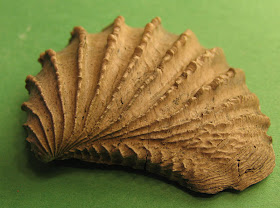It has taken a while to find an intact
specimen of this
brachiopod. It has special significance in the Louisville area. The fossil marks a zone of the
Jeffersonville Limestone. The small book entitled
Middle Devonian Type Jeffersonville Limestone at the Falls of the Ohio by James E.
Conkin, Barbara
Conkin, and Larry
Steinrock refers to this fossil quite a bit. The book and the Internet do not have good images for identification. Recently, I was lucky to find several complete ones. In the past, I have found the shells in rock plates, just one half, or fragments.

These specimens were found in
Jeffersonville Limestone and existed in the Middle Devonian Period.
This
brachiopod is known as the
Brevispirifer gregarius and the ones in this picture range in size of 1-1.5 cm wide, 1-2 cm tall. It was named by
Clapp in 1857 as
Spirifera gregaria. The
brachiopod is also found in Ohio in the Columbus Limestone.




Now that I have found some good specimens, I need to get a good photo of the Devonian Period horn coral
Bordenia knappi.
















 Update: August 2010, here is a picture of two Trigonia on display at the Smithsonian Museum of Natural History in Washington, D.C. The ones on the top are Trigonia thoracica (Late Cretaceous Period, Tennessee) and the bottom one is Trigonia moorei (Middle Jurassic Period, Australia).
Update: August 2010, here is a picture of two Trigonia on display at the Smithsonian Museum of Natural History in Washington, D.C. The ones on the top are Trigonia thoracica (Late Cretaceous Period, Tennessee) and the bottom one is Trigonia moorei (Middle Jurassic Period, Australia).






 Approximately 10 Cornulites attached to the outside of the shell.
Approximately 10 Cornulites attached to the outside of the shell.
 View of five worm tubes attached to inside of the shell.
View of five worm tubes attached to inside of the shell. Closeup of the shell edge with worm tubes.
Closeup of the shell edge with worm tubes.



